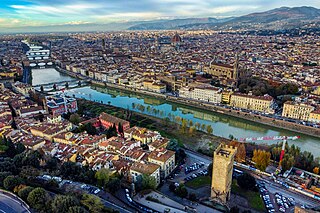
Florence is the capital city of the Italian region of Tuscany. It is also the most populated city in Tuscany, with 360,930 inhabitants in 2023, and 984,991 in its metropolitan area.

Vigevano is a comune (municipality) in the province of Pavia, in the Italian region of Lombardy. A historic art town, it is also renowned for shoemaking and is one of the main centres of Lomellina, a rice-growing agricultural district. Vigevano received the honorary title of city with a decree of Duke Francis II Sforza on 2 February 1532. It is famed for its Renaissance Piazza Ducale in the centre of the town.
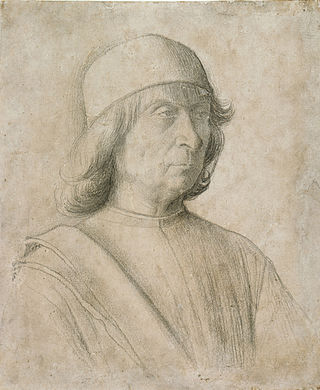
Gentile Bellini was an Italian painter of the school of Venice. He came from Venice's leading family of painters, and at least in the early part of his career was more highly regarded than his younger brother Giovanni Bellini, the reverse of the case today. From 1474 he was the official portrait artist for the Doges of Venice, and as well as his portraits he painted a number of very large subjects with multitudes of figures, especially for the Scuole Grandi of Venice, wealthy confraternities that were very important in Venetian patrician social life.

Simone Martini was an Italian painter born in Siena. He was a major figure in the development of early Italian painting and greatly influenced the development of the International Gothic style.

Jacopo d'Antonio Sansovino was an Italian Renaissance sculptor and architect, best known for his works around the Piazza San Marco in Venice. These are crucial works in the history of Venetian Renaissance architecture. Andrea Palladio, in the Preface to his Quattro Libri was of the opinion that Sansovino's Biblioteca Marciana was the best building erected since Antiquity. Giorgio Vasari uniquely printed his Vita of Sansovino separately.
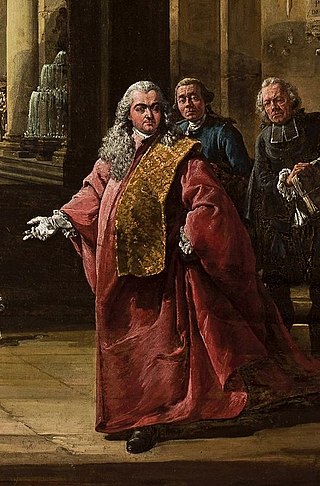
Bernardo Bellotto, was an Italian urban landscape painter or vedutista, and printmaker in etching famous for his vedute of European cities – Dresden, Vienna, Turin, and Warsaw. He was the student and nephew of the renowned Giovanni Antonio Canal, known as Canaletto, and sometimes used the latter's illustrious name, signing himself as Bernardo Canaletto. In Germany and Poland, Bellotto called himself by his uncle's name, Canaletto. This caused some confusion, however Bellotto’s work is more sombre in color than Canaletto's and his depiction of clouds and shadows brings him closer to Dutch painting.

Carlo Crivelli was an Italian Renaissance painter of conservative Late Gothic decorative sensibility, who spent his early years in the Veneto, where he absorbed influences from the Vivarini, Squarcione, and Mantegna. He left the Veneto by 1458 and spent most of the remainder of his career in the March of Ancona, where he developed a distinctive personal style that contrasts with that of his Venetian contemporary Giovanni Bellini.

Alessandro Bonvicino, more commonly known as Moretto, or in Italian Il Moretto da Brescia, was an Italian Renaissance painter from Brescia, where he also mostly worked. His dated works span the period from 1524 to 1554, but he was already described as a master in 1516. He was mainly a painter of altarpieces that tend towards sedateness, mostly for churches in and around Brescia, but also in Bergamo, Milan, Verona, and Asola; many remain in the churches they were painted for. The majority of these are on canvas, but a considerable number, including some large pieces, are created on wood panels. There are only a few surviving drawings from the artist.

Ambrogio Borgognone was an Italian painter of the Renaissance period active in and near Milan.
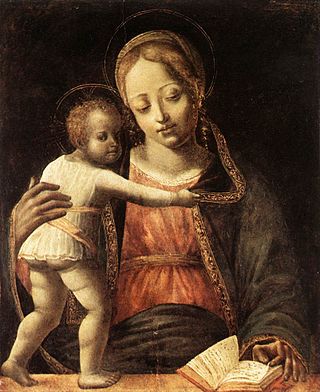
Bernardino Butinone was an Italian painter of the Renaissance, active mainly around Milan.

Giovanni Ambrogio de Predis was an Italian Renaissance painter, illuminator and designer of coins active in Milan. Ambrogio gained a reputation as a portraitist, including as a painter of miniatures, at the court of Ludovico Sforza.

Domenico Morone was an Italian painter from Verona, painting in an early Renaissance style. Much of his work has not survived, notably his fresco cycles. He was considered by Vasari to be second only to Liberale da Verona among artists in his town. His son Francesco Morone was also a prominent Veronese painter. His pupils included Michele da Verona and Girolamo dai Libri.
The decade of the 1480s in art involved some significant events.
The decade of the 1450s in art involved many significant events, especially in sculpture.
The decade of the 1410s in art involved some significant events.
Events from the year 1523 in art.

The Tempio Civico della Beata Vergine Incoronata is a Catholic church in Lodi, Lombardy, Italy. It is considered one of the masterworks of the Lombard Renaissance art. The church was designed in 1488 by Giovanni Battagio, continued by Gian Giacomo Dolcebuono and finished by Giovanni Antonio Amadeo, and built at expenses of the Lodi commune, whence the denomination "Civico" ("Municipal"), on the site previously occupied by a brothel.
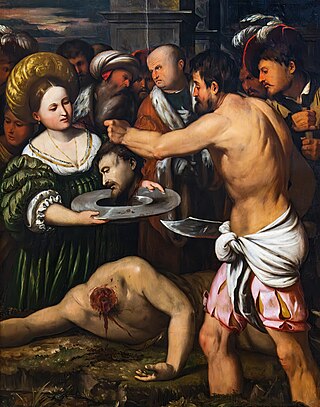
Callisto Piazza (1500–1561) was an Italian painter.

The Leonardeschi were the large group of artists who worked in the studio of, or under the influence of, Leonardo da Vinci. They were artists of Italian Renaissance painting, although his influence extended to many countries within Europe.
Alberto or Albertino Piazza (1490–1528) was an Italian painter. He was born and died in Lodi, Lombardy. His elder brother Martino was also a painter.















